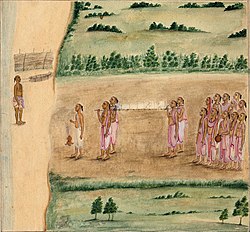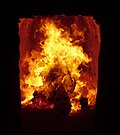Cremation

Cremation is the act of burning a body after it has died. Cremation is a popular option to dispose of (get rid of) a body instead of burying it. The place where cremations take place is called a crematorium or crematory.
Religions which approve cremation include Christianity, Jehovah's Witnesses, Buddhism, Hinduism, Jainism, Sikhism, Shinto, and Neopaganism. Traditional Judaism and Mormonism strongly discourage cremation, although the first reference to cremation in the Hebrew Bible is found in 1 Samuel 31, where it states that the dead bodies of Saul and his sons are burned, and their bones are buried.[1] Neo-Confucianism and Zoroastrianism disapprove it. Many Muslims believe cremation is forbidden. However, some Muslims, such as Quranists, believe cremation is permissible in Islam as there is no prohibition in the Qur'an against cremation, and that burial is not the only Islamic method that is approved by God.[2][3]
A natural gas cremation releases around 126kg of carbon dioxide.[4]
Ways of keeping or disposing of the cremated remains
Cremated remains (also called ashes) are returned to the person's family. The family then has a few options of what to do with the remains. Usually the ashes are buried in an urn at a cemetery plot just as a coffin is buried in normal earth burial. Many religions require the ashes to be handled in dignified manner. In Scandinavia it is customary to bury the ashes ín an urn in a family grave (a grave which contains the remains of many family members). Family graves are also popular in Japan and Thailand.
Sometimes the cremated person has thought about what they want to be done with their remains and have shared their desires with their family. Cremated remains can be kept in a container called an urn, which in turn can be buried on cemetery plot or placed in a depot called columbarium, or thrown into the air or water of a place that was special to the cremated person, or buried anonymously in the ground. These are the most popular choices of what to do with remains. There are also other, less common, options of how to dispose of the remains. Some examples of ways to scatter the remains are: through fireworks, shot from guns, or dropped from an airplane or hot air balloon. Remains can even be sent into space or turned into a diamond. The latter can be done because humans and diamonds are both made largely from carbon.
Queen Victoria, pioneer in cremation jewelry
Queen Victoria is the most well-known mourner because she went into a state of mourning for several decades. To honour her late Prince Albert, Queen Victoria "took to wearing black jet jewelry, from Whitby, in Yorkshire". As a limited and fairly difficult medium to work with, jet was expensive. It's a hard material, requiring skilled craftsmanship to avoid breakage during carving.
Cremation Media
An electric cremator in Austria
Bronze container of ancient cremated human remains, complete with votive offering
An 1820 painting showing a Hindu funeral procession in South India. The pyre is to the left, near a river, the lead mourner is walking in front, the dead body is wrapped in white and is being carried to the cremation pyre, relatives and friends follow.
The trial of William Price confirmed that cremation was legal in the United Kingdom. He was himself cremated after his death in 1893.
A sketch from the Vrba–Wetzler report, showing the rough layout of the crematoria used at Auschwitz, one of the several Nazi German extermination camps in occupied Poland
Cremation of a human corpse inside an electric cremator
A relic found amid the ashes of Chan Kusalo (the Buddhist Patriarch of Northern Thailand) is placed inside a chedi shaped vial and displayed inside Wat Chedi Luang in Chiang Mai.
Related pages
References
- Technical report #30 Archived 2005-03-24 at the Wayback Machine – Incineration of Human Bodies
- ↑ https://www.cremationsocietyofphiladelphia.com/bible-and-cremation/#:~:text=The%20first%20reference%20to%20cremation,and%20their%20bones%20are%20buried.
- ↑ https://www.quran-islam.org/articles/part_5/cremation__(P1503).html
- ↑ https://www.ahl-alquran.com/arabic/show_article.php?main_id=15614
- ↑ Wright, Robert (2023-11-29). "Families seek green alternatives to traditional funerals". Financial Times. https://www.ft.com/content/5e33fba5-9dc5-483b-9f70-873740774e6d. Retrieved 2023-12-02.
Other websites
| Wikimedia Commons has media related to Lua error in Module:Commons_link at line 62: attempt to index field 'wikibase' (a nil value).. |
- Cremation Association of North America Archived 2002-09-14 at the Library of Congress Web Archives
- International Scattering Society Archived 2007-02-20 at the Wayback Machine
- Crematory in Europe







